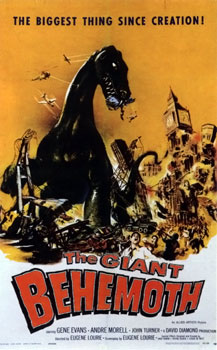
BEHEMOTH THE SEA MONSTER
UK, 1959, 70 minutes, Black and white.
Gene Evans, Andre Morrell.
Directed by Eugene Lourie and Douglas Hickox.
The B Feature was a popular aspect of the double bills, especially in English-speaking countries. They were churned out by the American industry as well as by the British from the 1930s to the 1960s. The coming of television did not immediately halt their production or popularity but, at the beinning of the 1960s, with the big-budget widescreen films that were becoming more and more popular, there was little place for these films.
When the Americans began making telemovies in the late 1960s, these became the alternative to the B films.
However, there were still a number of film-makers who made genre pictures during the 1970s, often Z budget in production and imagination. Later, the successors of these films were the straight-to-video and straight-to-DVD films of the 1990s and into the 21st century.
In the United States, especially with the popular serials that took on themes of science and even space exploration, the 1950s saw a proliferation of short science fiction films, some of them now considered excellent examples of their type, others were just schlock.
One of the features of these films was the atomic age and many of the films were warnings about radiation dangers and the possibilities of mutations and monsters. Godzilla emerged from this period. Space also fascinated film-makers and audiences at this time. The first Sputnik was launched in 1957 and soon after the first astronauts went into space. The moon landing was in 1969. Many of the films (even Kubrick’s 1968 2001: a Space Odyssey) tried to imagine what space travel would be like. There was a huge spate of space films.
Unfortunately, special effects were quite limited at the time and many audiences would find these quite risible. However, taken in their time, they had their impact.
This was the period of Ed Wood and his Planet 9 from Outer Space but also the beginning of the career of Roger Corman and his many protégés who became top-class directors.
There had been a Hollywood tradition of horror since the 1930s which led to many spoofs. However, all kinds of horror made a comeback in the 1950s, not only in the shockers from the US but also from Hammer Studios in England. These films also continued throughout the 1960s and 1970s and influenced some of the poorer directors like Ted. V. Mikels with films like The Corpse Grinders. These films, along with the popularity of the blaxploitation films now show their age with their characteristic costumes and hair styles, the touch sometimes of the psychedelic and the grainy film stock.
Behemoth the Sea Monster is a British version of so many of the American B-features of the 1950s which were concerned about the atomic age and the repercussions of the hydrogen bombs and the tests. There is a speech towards the beginning at a conference which explains the knock-on effect of the radiation affecting plankton, being eaten by fish and so on, so that there is a huge contamination.
The film, in the vein of Godzilla, and in the director’s Gorgo made two years later, a rampant monster emerges and terrorises the city and destroys it. This time it is London.
The film has a brief running time, has an American star, Gene Evans as well as a solid British presence in Andre Morrell who was to make a number of films for Hammer Studios. The dialogue is strong, giving scientific accounts of what is happening as well as providing some action as the armed forces try to destroy the monster.
1.The popularity of this kind of film in the 1950s? B-budget? Supporting feature?
2.The message, the experience of the atomic age, of testing of bombs, the repercussions for the environment? The theme ahead of its times?
3.The black and white photography, the London settings? The Cornwall beaches, the sea? The special effects for Behemoth and other destructive sequences? The musical score?
4.The opening, the presentation of the background, the visuals of the explosions, the explanation about the cumulative effect of radiation from the seas? The establishing of the character of the American scientist, the English scientist? The armed forces? Panic or not?
5.The Cornish coast, the fisherman, the dead fish on the sea, his daughter, going to the pub, not finding her father, the visualising of his death? His talking about the monster?
6.The monster itself, emerging from the sea, moving through the city, destruction?
7.The professor, the American, the submarine commander? The plans, the attempts to kill the monster, the failures? Underwater, target, destruction?
8.The sense of achievement, hope?
9.The ending, as with so many horror films, the news of the dead fish on the American beaches? A film of entertainment, with the horror touch, with the warning message?